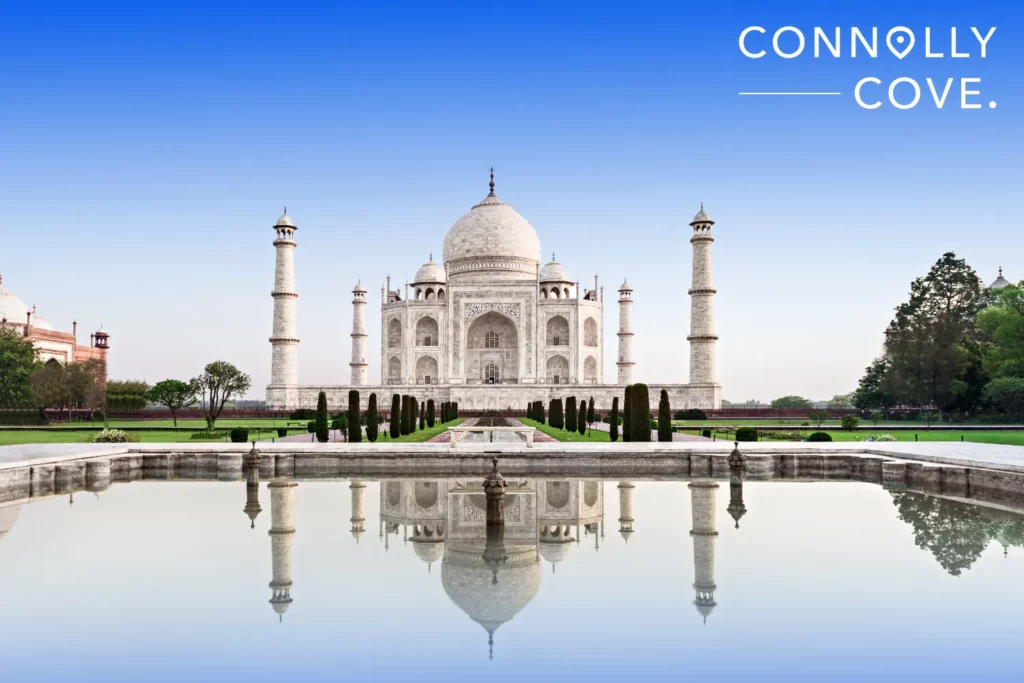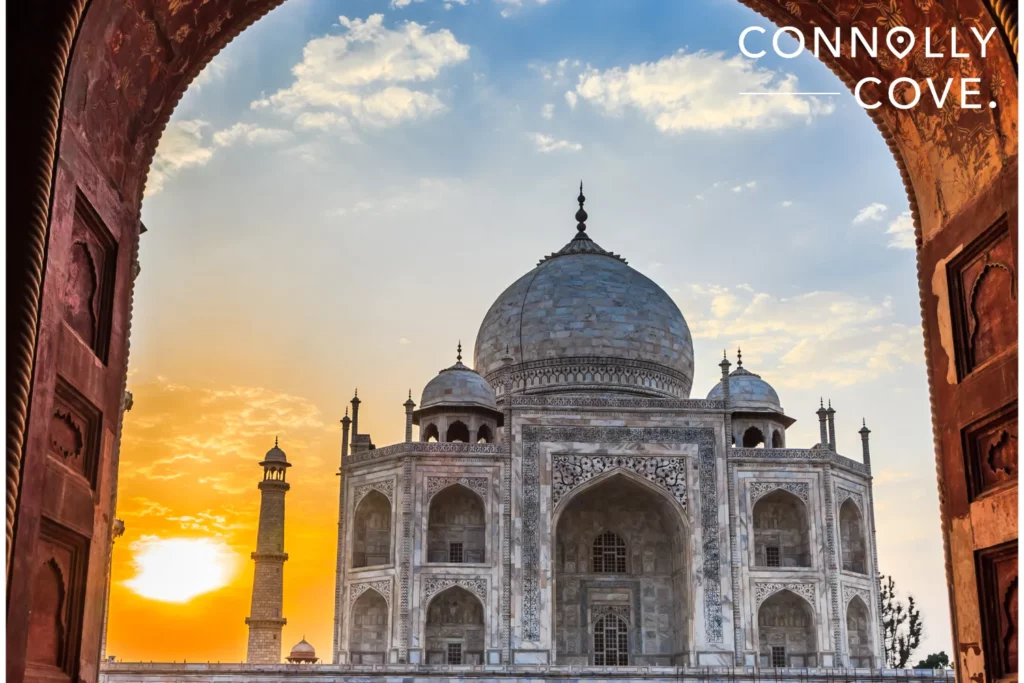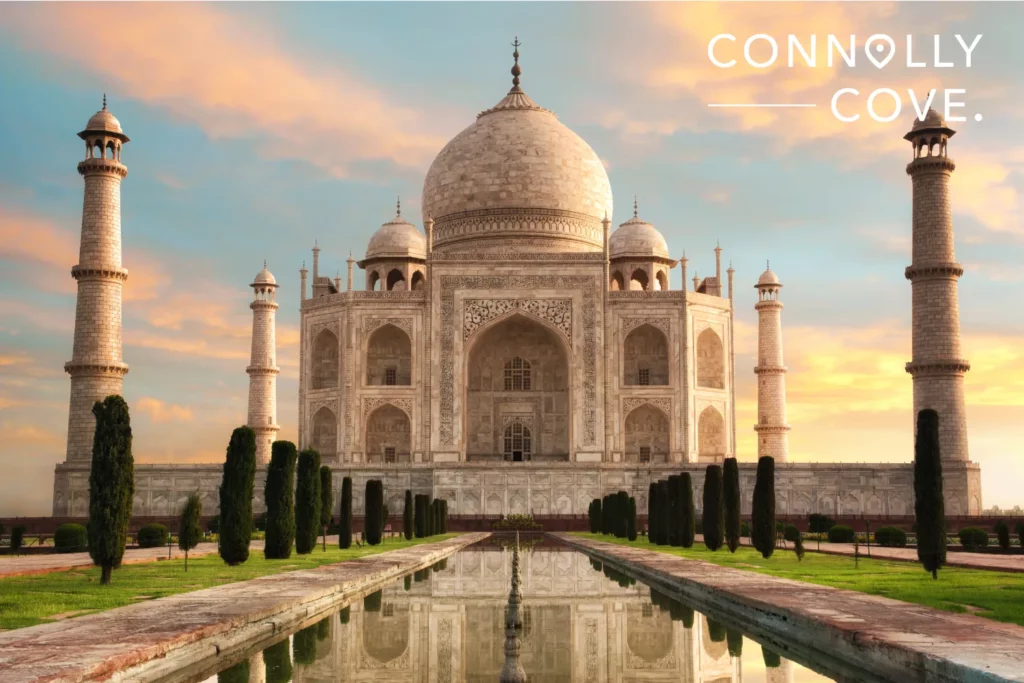India’s Taj Mahal: Only 1 Story of Eternal Love

Updated On: November 09, 2023 by Marwa Abdel Moniem
Chances are you’ve heard about the story of eternal love behind the ivory white-marble palace in India, and you might as well have seen pictures of it, but the truth is such a curious search can never do the Taj Mahal justice. There is a moral behind the story and a diamond of beauty standing on the right bank of the Yamuna River, making it a landmark in India and the whole world.
This masterpiece of construction is a UNESCO World Heritage Site with unique features found nowhere else. There is only one Taj Mahal in this world, and it was meant to be a one-and-only, just as true love comes once in a lifetime.
True love is the answer to why this place was built in the first place. Interested to know more about it? Read on for an insider’s look into the history and architecture of the most prominent monument of India, which has also served as a perfect setting for many movies and a favourable destination for many world stars and leaders.
Table of Contents
The Story of the Taj Mahal in India

A place where soulmates can meet! That’s probably what Shah Jahan, the fifth Mughal emperor, had in mind when he ordered the construction of the Taj Mahal in Arda, India.
In a show of undying love, Shah Jahan had this palace built in memory of his favourite wife, Mumtaz Mahal, who had died while giving birth to their child. Construction took place between 1632 AD and 1648 AD.
The most beautiful tomb in the world was built for the Muslim princess, whose name in English roughly translates into “the jewel of the palace”. It was the name Shah Jahan gave his beloved Empress consort. The Taj Mahal translates into “the crown of the palace”.
The main gateway, a mosque, a guest house, and the outer courtyard were later built in 1653 AD and are now part of the mausoleum complex.
“O SOUL, THOU ART AT REST. RETURN TO THE LORD AT PEACE WITH HIM, AND HE AT PEACE WITH YOU.”
Arabic Inscriptions on the Walls
Carved in black marble, the Arabic lettering decorates the mausoleum, where the actual graves of both Mumtaz Mahal and Shah Jahan are kept safe and sealed in its basement.
The cenotaphs are preserved in an undecorated burial room below a main chamber, which features polished gemstones and houses empty tombs of the emperor and his beloved wife. The actual graves are closed to the public.
Legend has it that Mumtaz Mahal had this dream to be buried in the most beautiful tomb — her husband saw to it that it came true. The Taj Mahal is living evidence of pure love that is immortalised in white marble and bears the heartbreaks of a soulmate. Indeed, love is the architect of the Taj Mahal!
A Gem of Islamic Art in India

A jewel it is! That is what best describes the Taj Mahal, which was built by the most skilled artisans using the finest materials to come out with this most beautiful mausoleum in the history of humankind.
Thirty-seven artisans had put their magical touches on the construction. One was called from Baghdad mainly to carve the curved Arabic letters, and another from Bukhara City to polish the flowers on the marble stone. Some others arrived from Istanbul to build the domes, and some from Samarkand to build the minarets. All worked together to construct this masterpiece — the Taj Mahal.
Located about 200 kilometres from New Delhi, it is built on a 6.5-metre-high platform. Its perfect symmetry shows in the layout with a central dome surrounded by minarets.
A green garden carpet stretches from the main gateway to the foot of the Taj. Two marble canals equally divide the garden into four parts that all end at a raised central lotus-shaped pond. The two canals are lined with cypress trees, which symbolise death.
Bucking the trend of Mughal mausoleums, the Taj Mahal is not found in the centre but at the north end, just above the Yamuna River. Inside, octagonal chambers are connected with passages, with the floor made of contrasting tiles. The walls feature black inscriptions over white marble, making it beautifully articulate.
Pure white marble that was specifically brought from the region of Makrana in Rajasthan was used in the construction because of its extraordinary lustre and delicate texture. Selected verses of the Holy Quran are inscribed on the marble at the main entrance to the Taj Mahal.
To the west of the spectacular complex stands a mosque built of red sandstone. The mosque completes the picture of a Muslim mausoleum, which should have a place for prayers. The weekly Muslim prayers are still performed at this mosque on Fridays, while the Taj Mahal remains closed to visitors.
The Dome
A classic Persian dome located in the centre of the Taj Mahal captures the eyes of visitors with its awe-striking beauty. This bulbous dome is 35 metres high and is situated on the flat roof of the palace. It is surrounded by four smaller domes at each corner of the Taj Mahal.
The four minarets at each of the corners give a tremendous 3D effect that amuses the beholders. Made of white marble, this arch-and-dome profile has become iconic of the Taj Mahal.
Precious Stones for a Precious Wife!
Dedicated to the Shah’s most precious wife, the Taj Mahal was decorated with 28 varieties of precious and semi-precious stones. We are talking about 625 diamonds, 42 emeralds, 50 pearls, 142 rubies and thousands of onyx. Yes, Mumtaz Mahal was that precious!
The Magnificent Waterfront

For an even more picturesque view of the Taj Mahal, a waterfront was created with 24 fountains on its four sides. This lotus-shaped pond ensures a magical reflection of the Taj Mahal on the water that flows from the Yamuna River into the pool. This is really something to see!
The Secret Rooms
The Taj Mahal contains 120 rooms and a hall of mirrors called “Sheesh Mahal”. In there also stands a fountain-like structure that simulates the effect of rain. No, you are not daydreaming — remember, this is one of the finest examples of perfection in the world!
There are also 22 rooms on a secret floor, and those are sealed with bricks. The secret floor is found beneath the marble platform of the Taj Mahal.
The Changing Colours
The Taj Mahal has always succeeded in surprising its visitors with its magnificent features. This palace has been designed to change its colours three times a day. Marble is the keyword.
It is this marble couture that makes the Taj Mahal visible at night without any need for lighting, especially when it is a full moon. The marble changes colour, appearing pale pink in the morning, dazzling white at noon, orange-bronze during sunset and light blue late at night.
A Rightly Wonder of the World in India
It is no surprise that the Taj Mahal has been named one of the modern Seven Wonders of the World, given its impressive architecture and intricate details that make it the most popular tourist attraction in India. The Taj Mahal mausoleum complex has been protected since 1983, when it was designated as a UNESCO World Heritage Site.
A Perfect Filming Location
From Bollywood to Hollywood, the Taj Mahal has been chosen as the most suitable location for many movies. Filmmakers of more than 300 movies have decided to get their cameras rolling in the Taj Mahal.
The beginning was in 1941, when “Taj Mahal” hit the screens, starring actress Suraiya and actor Muhammad Naseem, who played Mumtaz Mahal and Shah Jahan, respectively. It was Suraiya’s acting debut.
A brief part of “Slumdog Millionaire” was shot at the Taj Mahal, where Jamal becomes a tour guide. This British adaptation of the novel Q & A by Indian author Vikas Swarup was released in 2008.
Starring Jackky Bhagnani and Neha Sharma, “Youngistaan” was one of the movies filmed at the Taj Mahal. The crew was able to shoot a song and a few scenes at the iconic palace.
In the movie “Aladdin”, the magnificent palace of the sultan was inspired by the Taj Mahal in India.
High-profile Visits!
Why would a celebrity or a public figure travel all the long distance to visit the Taj Mahal? The answer could be easily guessed —this is beauty to the eyes. The lovely palace should be seen at least once in a lifetime.
Princess Diana, the Queen of the Hearts, visited the Taj Mahal alone in 1992. While solo photos of the late princess were captured during her February visit to the mausoleum, Prince William, Diana’s son, and his wife, Kate Middleton, posed for a picture together during their visit to the Taj Mahal in 2016.
Spotted visiting the Taj Mahal was Mark Zuckerberg, the CEO of Facebook. Of course, he shared pictures of the visit that many of his followers liked.
Among the celebrities who visited the Taj Mahal were Tom Cruise, Oprah Winfrey, Julia Roberts and Leonardo DiCaprio. Former heavyweight boxer Mike Tyson and his wife, Lakiha Spicer, visited the Taj Mahal and posed for a memorable picture.
US President Donald Trump visited the iconic Taj Mahal with his family, and French President Emmanuel Macron and First Lady Brigitte Macron visited the mausoleum in the Indian city of Agra.
Worth a Visit!
To say that the Taj Mahal is famous for India could be more accurate than the other way around. In fact, India gains much of its tourist flows from the Taj Mahal, which alone attracts between seven to eight million visitors every year.
No traffic is allowed near the mausoleum complex. Instead, visitors will have to either walk from the parking lots or take the electric bus. There are two separate tickets to the gardens and the mausoleum. We recommend that you purchase both tickets for a complete trip to this magnificent palace —the Taj Mahal.






